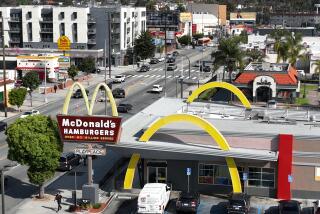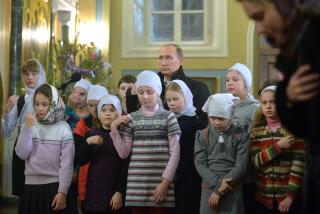‘Sticker Shock’ Jolts Soviets on Eve of Huge Price Boosts
MOSCOW — Contemplating five slices of outrageously expensive smoked sturgeon in an otherwise barren fish store, the Soviet army colonel got a glimpse of the future Monday afternoon, and he wasn’t happy.
The pearly-white delicacy cost 60 rubles a kilogram, or about an average factory worker’s entire weekly paycheck for two pounds. “Does it really sell at this price?” the stocky, puffy-faced officer wanted to know.
Not getting a clear answer from shop clerks, he stalked out.
Starting today, the colonel and his compatriots will have nowhere to run from high prices. First broached in a speech 3 1/2 years ago by Soviet President Mikhail S. Gorbachev, “price reform”--a euphemism for astronomical boosts in the retail prices of most consumer items and foodstuffs--begins today in earnest.
For a country whose last major retail price increases came in the 1950s and 1960s, under Nikita S. Khrushchev, the consequences of today’s Kremlin action are expected to be a colossal shock.
Prices of some types of bread, the staple in the Soviet carbohydrate-rich diet, will be boosted 400%. On electronics equipment, meat, tomatoes and many other goods, prices will double or skyrocket by as much as 1,000%.
Defending the hugely unpopular step, Prime Minister Valentin S. Pavlov says such increases are indispensable to slash state subsidies that run into the tens of billions of rubles yearly, and to stimulate flagging production by allowing factories and collective farms to turn a profit.
The way the Kremlin leadership is presenting it, today’s “price reform” is the boldest step yet toward a market-style economy, where prices bear some relation to costs.
Nevertheless, although people are supposed to get a monthly 60-ruble bonus and other forms of compensation to soften the blow, it is one more hardship many here will blame on Gorbachev’s zigzagging, six-year-old quest to reform the economy and society.
“Unrest is possible, and we should expect it,” said Moscow’s deputy mayor, Sergei B. Stankevich.
He told reporters Monday that the Moscow city government had begun stockpiling bread and basic commodities for citizens who can’t afford the new prices.
Like a plague of locusts, consumers swept through stores in Moscow and other cities over the weekend, buying up whatever they could find--even bread and rolls.
In Tashkent, a Central Asian city of more than 2 million, every loaf of bread on sale was reportedly bought.
Because Gorbachev alerted people in March of the pending price increases, and even told them the exact date, there seems to have been little consumer panic, as there was last May when government officials first floated the idea of a possible doubling of food prices.
This time, Soviet citizens seemed to stand patiently in line to take their turn at stripping state-run stores. That is, when they could find a line to stand in.
Many shops, including numerous bakeries in Moscow, closed when they ran out of goods.
Although Pavlov and his governmental colleagues stress the sincerity of their efforts to compensate the populace, other officials warn that the average person’s buying power is going to be slashed to the bone, even to something akin to near-subsistence levels.
“Obviously, people will have to cut back on their food consumption, to save on transportation, to stop going to movies, theaters, etc.,” warned Yuri M. Luzhkov, chairman of the Moscow government’s executive committee.
“Only absolutely vital items will now be purchased,” Luzhkov said. “People will rely on their own skills in mending footwear and clothes, as well as repairing their apartments.”
It is impossible to meaningfully translate ruble costs into dollars, because the Soviet government fixes artificial exchange rates that do not reflect the market value of the currency. But as one indication of the impact the price boosts will have, Luzhkov said a homemaker who now spends 10 to 12 rubles on daily grocery shopping will now have to lay out 30 rubles or more--three times as much.
Harsh Soviet-made cigarettes will double in price. Dry cleaning will cost up to 300% more. A lunch in a factory canteen, now 1.20 rubles, will triple in price.
Just by continuing to eat at the canteen, Luzhkov noted, a worker will consume his entire monthly 60-ruble compensation payment.
In a decision laden with symbolism, the Moscow City Council voted Monday to triple the price of a trip on the city’s subway to 15 kopecks, in the first fare increase since dictator Josef Stalin began building the underground railway and its palatial stations more than half a century ago.
Soviet authorities, well aware of what sort of social explosion they may be risking, have taken some measures in advance to compensate. Officials plan to push onto store shelves six to eight weeks’ worth of goods that are now lying in warehouses.
Such bounty would demonstrate to shortage-weary consumers that although they now must pay more, they will also have more to choose from.
A government ban has also been slapped on demonstrations in Moscow through mid-April, apparently in part to prevent consumer grumbling from bursting out onto the city’s streets.
For opponents of the Soviet government, the price increases, like Pavlov’s decision earlier this year to suddenly withdraw 50- and 100-ruble bank notes from circulation, is proof that the Kremlin leadership is not interested in bettering people’s lot.
“We see this as robbery,” Moscow progressive Vladimir Boxer charged.
Leaders of the left-wing Democratic Russia faction in Russia’s Parliament charged that the price rises will cut most of their fellow citizens’ standard of living by half and said they plan to oppose them, possibly by calling for strikes.
SOARING SOVIET PRICES
Examples of old and new prices under “price reform.” There are 100 kopecks to a ruble. An average factory worker earns 60 rubles a week: * Box of matches, 1 kopeck, now 5 kopecks
* Lead pencil, 2 kopecks, 12 kopecks
* Bottle of beer, 1 1/2 rubles, 3 rubles
* Tea kettle, 6 rubles, 12 rubles
* Man’s suit, 200 rubles, 500 to 700 rubles
* Rubin brand color TV set, 755 rubles, 1,128 rubles
* Lada car, about 8,500 rubles, about 16,000 rubles
Source: Komsomolskaya Pravda newspaper
More to Read
Sign up for Essential California
The most important California stories and recommendations in your inbox every morning.
You may occasionally receive promotional content from the Los Angeles Times.










